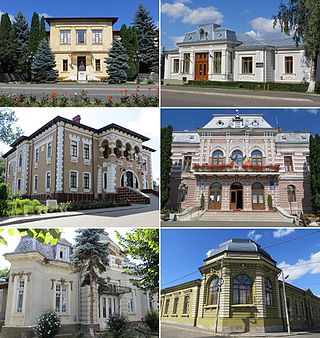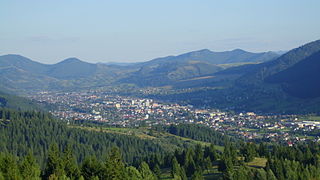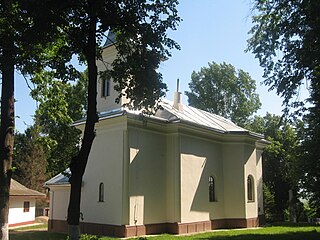
Suceava County is a county of Romania. Most of its territory lies in the southern part of the historical region of Bukovina, while the remainder forms part of Western Moldavia proper.

Suceava is a city in northeastern Romania. The seat of Suceava County, it is situated in the historical regions of Bukovina and Moldavia, northeastern Romania. It is the largest urban settlement of Suceava County, with a population of 84,308 inhabitants according to the 2021 Romanian census.

Fălticeni is a town in Suceava County, northeastern Romania. It is situated in the historical region of Western Moldavia. According to the 2021 census, Fălticeni is the third largest urban settlement in the county. It was declared a municipality in 1995, along with two other cities in Suceava County: Rădăuți and Câmpulung Moldovenesc.

Beclean is a town in Bistrița-Năsăud County, in north-eastern Transylvania, Romania. The town administers three villages: Coldău, Figa (Füge), and Rusu de Jos (Alsóoroszfalu).

Gura Humorului is a town in Suceava County, northeastern Romania. It is situated in the historical region of Bukovina.

Rădăuți is a town in Suceava County, north-eastern Romania. It is situated in the historical region of Bukovina. According to the 2021 census, Rădăuți is the second largest urban settlement in the county. It was declared a municipality in 1995, along with two other cities in Suceava County: Fălticeni and Câmpulung Moldovenesc. Rădăuți covers an area of 32.30 km2 (12.47 sq mi) and it was the capital of former Rădăuți County.

Vatra Dornei is a town in Suceava County, north-eastern Romania. It is situated in the historical region of Bukovina. Vatra Dornei is the fifth largest urban settlement in the county, with a population of 12,578 inhabitants, according to the 2021 census.

Câmpulung Moldovenesc is a city in Suceava County, northeastern Romania. It is situated in the historical region of Bukovina.

Vicovu de Sus is a town in northern Suceava County, on the border with Ukraine. It is situated in the historical region of Bukovina.

Siret is a town, municipality and former Latin bishopric in Suceava County, northeastern Romania. It is situated in the historical region of Bukovina. Siret is the 11th largest urban settlement in the county, with a population of 6,708 inhabitants, according to the 2021 census. It is one of the oldest towns in Romania and was the capital of the medieval Principality of Moldavia during the late 14th century. Furthermore, the town administers two villages: Mănăstioara and Pădureni.

Hertsa or Hertza is a town located in Chernivtsi Raion, Chernivtsi Oblast in western Ukraine and has a population of 2,097.

Solca is a town in Suceava County, northeastern Romania. It is situated in the historical region of Bukovina. Solca is the smallest town in the county and the third-smallest town in Romania, with a population of 2,405 inhabitants, according to the 2021 census. Its name is derived from that of the river flowing through it, in turn derived from Slavic sol ("salt") – in reference to the area's salty springs. Solca is known for its high quality air, for being a former spa, and for the beer that was manufactured here.

Salcea is a town in Suceava County, in the Western Moldavia region of northerneastern Romania, with a population of 9,513. It administers four villages: Mereni, Plopeni, Prelipca, and Văratec. Salcea was declared a town in 2004.

Dolhasca is a town in Suceava County, in the historical region of Western Moldavia, northeastern Romania. Dolhasca is the eighth largest urban settlement in the county, with a population of 11,007 inhabitants as of 2021. It was declared a town in 2004, along with seven other localities in Suceava County. The town administers seven villages, namely: Budeni, Gulia, Poiana, Poienari, Probota, Siliștea Nouă, and Valea Poienei.

The Bukovina Germans, also known and referred to as Buchenland Germans, or Bukovinian Germans, are a German ethnic group which settled in Bukovina, a historical region situated at the crossroads of Central and Eastern Europe, during the modern period. They are part of the larger group of Romanian Germans since the early 20th century, when they were initially living in the Kingdom of Romania.

Cacica is a commune in Suceava County, in the historical region of Bukovina, northeastern Romania. The commune is located in the central part of the county, 17 km (11 mi) from the town of Gura Humorului, 34 km (21 mi) from the city of Rădăuți, and 28 km (17 mi) from the county seat, Suceava. At the 2011 census, 74.8% of inhabitants were Romanians, 20.2% Poles, and 4.4% Ukrainians. Its Polish inhabitants are descended from settlers who arrived there at the turn of the 19th century during the Habsburg period.

Broșteni is a town in Suceava County, in the historical region of Western Moldavia, northeastern Romania. Broșteni is the fourteenth largest urban settlement in the county, with a population of 5,179 inhabitants, according to the 2021 census. It was declared a town in 2004, along with seven other localities in Suceava County. The town administers the former villages of Hăleasa, Lungeni, and Neagra, and Cotârgași, Dârmoxa, Frasin, Holda, Holdița, and Pietroasa.

Frasin is a town in Suceava County, mountainous northeastern Romania. It is situated in the historical region of Bukovina. Frasin is the thirteenth-largest urban settlement in the county, with a population of 5,817 according to the 2021 census. It was declared a town in 2004, along with seven other localities in Suceava County. The town administers the former village of Bucșoaia, Doroteia, and Plutonița.

Liteni is a town in Suceava County, northeastern Romania. It is situated in the historical region of Western Moldavia. Liteni is the ninth-largest urban settlement in the county, with a population of 8,878 inhabitants, according to the 2021 census. It was declared a town in 2004, along with seven other localities in Suceava County. The town administers five villages, namely: Corni, Roșcani, Rotunda, Siliștea, and Vercicani.

Milișăuți is a town in Suceava County, northeastern Romania. It is situated in the historical region of Bukovina. Milișăuți is the fifteenth largest urban settlement in the county, with a population of 4,657 inhabitants, according to the 2021 census.
























